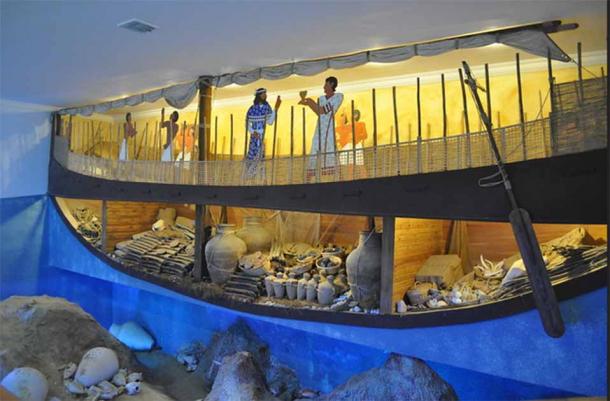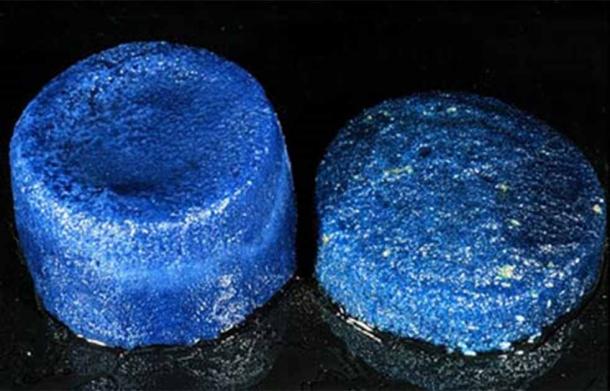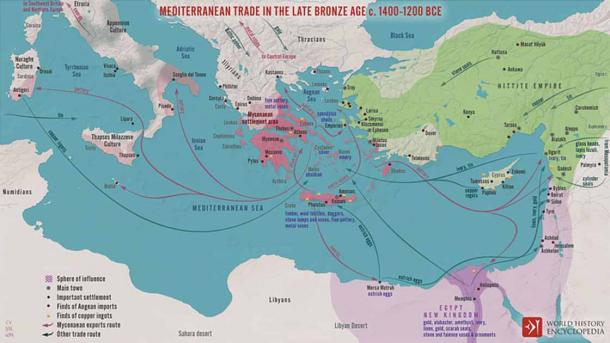
Uluburun is a 3,300-year-old shipwreck discovered off the coast of Uluburun (Grand Cape), near Kaş, southwest Türkiye. It is one of the oldest ships ever discovered and contains one of the richest and most important assemblages of Late Bronze Age objects found in the Mediterranean. The ship carried more than 20 tons of goods, believed to have been commissioned by the royal family. In total, more than 18,000 breathtaking artifacts were found, including precious jewelry, luxurious raw materials and even the golden seal of Egyptian Queen Nefertiti.
The oldest ship, Uluburun
Uluburun was first discovered in 1982 by Mehmed Çakir, a local sponge diver, on a steep rocky slope at a depth of 44 to 52 meters (144 .35 to 170.60 feet), with artifacts scattered up to 61 meters (200.13 feet). The excavation was a mammoth task and required 11 consecutive campaigns lasting 3 to 4 months, carried out by the Institute of Maritime Archeology, totaling 22,413 dives from 1984 to 1992.
The ship itself The ship is 15 meters long (49 .21 feet long) and is the first known example of a ship built using the advanced mortise and tenon technique, in which planks are joined together by flat strips of wood inserted into grooves cut in the panels plank. The wood is Lebanese cedar, sourced from the mountains of Lebanon, southern Türkiye and central Cyprus.

Treasures and Luxurious Goods Have Pointed to an International Trade Network
At the time of sinking, the ship was carrying over 20 tons of cargo, including both raw materials and finished goods, which have been traced back to at least seven different cultures, including Mycenaean, Syro-Palestinian (forerunners of the Phoenicians), Cypriot, Egyptian, Kassite, Assyrian and Nubian.
The main cargo was approximately 10 tons of primarily Cypriot copper in the form of 354 ingots. The Uluburun also contained the earliest known intact ingots of glass; 175 of disc-shape were recovered, which were colored with cobalt blue, turquoise, and a unique lavender.

Other raw materials included a ton of terebinth resin contained in around 150 Canaanite jars (most likely for incense), logs of Egyptian ebony, ostrich eggshells, elephant tusks, hippopotamus teeth, seashells, and tortoise shells.
The finished products are equally luxurious: Egyptian objects made of gold, silver, silver and stone; Canaanite jewelry; thousands of beads in glass, agate, carnelian, quartz, terracotta and amber; and finely crafted figurines, including a bronze female figure, partly gilded, of Syrian-Palestinian origin. One of the most unique and valuable items is a scarab bearing the image of Queen Nefertiti.
Other artifacts include ivory cosmetic containers, a trumpet carved from the incisors of a hippopotamus, bronze tools and weapons, sinkers for nets and lead wires, netting needles for mending nets, fishing hooks, harpoons, bronze tridents and wooden writing tablets. However, the largest group of manufactured goods on board were fine and coarse Cypriot ceramics.
An analysis of items that were the personal property of the crew members, such as tools, oil lamps, and writing boards, suggests that the crew were Canaanites and/or Cypriots, although at least two were Mycenaean.
The provenance of the artifacts suggests that the Late Bronze Age Aegean was part of an international trade network probably based on royal gifts to the Near East, through which ships passed The Mediterranean follows a circular route from Syro-Palestine to Cyprus, into the Aegean Sea, and sometimes as far west as Sardinia, then back via North Africa and Egypt.

Research Continues
The study of the Uluburun shipwreck is ongoing. The researchers are still working to identify all of the objects that were found on the ship . They are also continuing to study the chemical and isotopic composition of the ingots to learn more about their origins. The shipwreck is a valuable source of information about the ancient world, and the new study provides further insights into the complex trade networks and cultural exchanges that were taking place at the time.
In 2022, a team of scientists, from Arts & Sciences at Washington University in St. Louis, discovered small communities of highland pastoralists living in present-day Uzbekistan in Central Asia made and provided roughly one-third of the tin found aboard the ship. This tin that was on the way to markets in Mediterranean to be converted into the popular bronze metal.
The Uluburun is considered one of the most important and fascinating sea wrecks ever discovered, and has provided archaeologists with an abundance of information about ancient society and culture across the Mediterranean, including Bronze Age ship building, sea routes, trading practices, and the production and exchange of raw materials and luxurious goods. Today, the remains of the Uluburun and its cargo are housed in the Bodrum Museum of Underwater Archaeology .
Top image: Replica of the Uluburun shipwreck.
Source: Antalya Info






